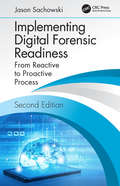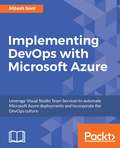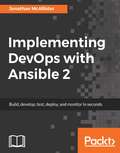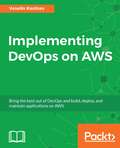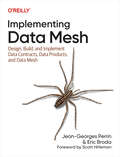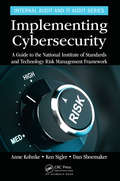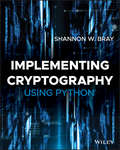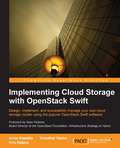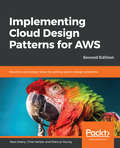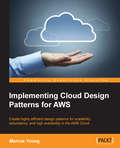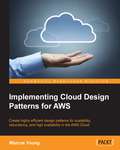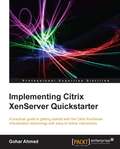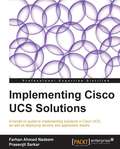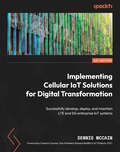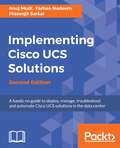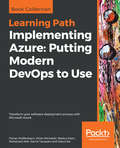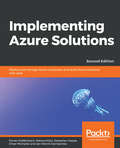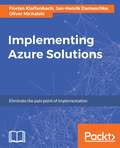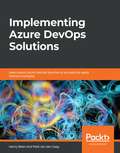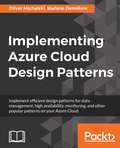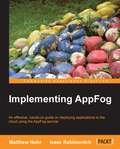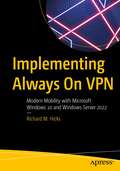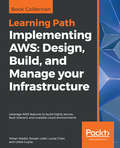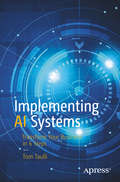- Table View
- List View
Implementing Digital Forensic Readiness: From Reactive to Proactive Process, Second Edition
by Jason SachowskiImplementing Digital Forensic Readiness: From Reactive to Proactive Process, Second Edition presents the optimal way for digital forensic and IT security professionals to implement a proactive approach to digital forensics. The book details how digital forensic processes can align strategically with business operations and an already existing information and data security program. Detailing proper collection, preservation, storage, and presentation of digital evidence, the procedures outlined illustrate how digital evidence can be an essential tool in mitigating risk and redusing the impact of both internal and external, digital incidents, disputes, and crimes. By utilizing a digital forensic readiness approach and stances, a company’s preparedness and ability to take action quickly and respond as needed. In addition, this approach enhances the ability to gather evidence, as well as the relevance, reliability, and credibility of any such evidence. New chapters to this edition include Chapter 4 on Code of Ethics and Standards, Chapter 5 on Digital Forensics as a Business, and Chapter 10 on Establishing Legal Admissibility. This book offers best practices to professionals on enhancing their digital forensic program, or how to start and develop one the right way for effective forensic readiness in any corporate or enterprise setting.
Implementing DevOps with Microsoft Azure
by Mitesh SoniAccelerate and Automate Build, Deploy, and Management of applications to achieve High Availability. About This Book • This guide highlights tools that offer development and deployment environments for application services • Secure and continuously monitor your web application in order to make it highly available • Use Visual Studio Team Services for Continuous Integration and Continuous Development to expedite your application life cycle management process • Use Microsoft Azure App Services (Azure Web Apps / Azure Websites), PaaS offering from Microsoft to deploy web application Who This Book Is For This book is for DevOps engineers, system administrators, and developers (.net) who want to implement DevOps for their organization. You do not need to have any knowledge of VSTS or Azure App Services (Azure Web Apps / Azure Websites). What You Will Learn • Explore the features of PaaS and aPaaS in DevOps • Use Visual Studio Team Services (VSTS) to manage versions of code and integrating VSTS with Eclipse IDE • Understand and configure Continuous Integration in VSTS • Review Unit Test Execution for Automated Testing • Create different environments that can be used to continuous deploy a web application • Configure Roll-based Access to enable secure access for Azure Web Apps • Create and configure the App Service Environment to enhance security • Understand the execution of the end-to-end automation process • Conduct Performance Testing using JMeter • Discover the different monitoring options available in Microsoft Azure Portal In Detail This book will teach you all about the Visual Studio Team Services and Microsoft Azure PaaS offerings that support Continuous Integration, Continuous Delivery, Continuous Deployment, and execution in the cloud with high availability, disaster recovery, and security. You will first be given a tour of all the concepts and tools that Microsoft Azure has to offer and how these can be used in situations to cultivate the DevOps culture. You'll be taught how to use and manage Visual Studio Team Services (VSTS) and about the structure of the sample application used throughout the book. You will become familiar with the nitty gritty of Continuous Integration and Continuous Development with VSTS and Microsoft Azure Apps. You will not only learn how to create App service environments, but also how to compare Azure Web Apps and App Service Environments to deploy web applications in a more secure environment. Once you have completed Continuous Integration and created the Platform for application deployment, you will learn more about the final stepping stone in achieving end-to-end automation using approval-based Continuous Delivery and Deployment. You will then learn about Continuous Monitoring, using the monitoring and notification options provided by Microsoft Azure and Visual Studio Team Services. Style and Approach This book is an easy-to-follow guide filled with examples and real-world applications for gaining an in-depth understanding of Microsoft Azure and Visual Studio. This book will help you leverage Microsoft Azure and Visual Studio using real-world examples.
Implementing DevOps with Ansible 2
by Jonathan McallisterLeverage the power of Ansible 2 and related tools and scale DevOps processes About This Book • Learn how to use Ansible playbooks along with YAML and JINJA to create efficient DevOps solutions • Use Ansible to provision and automate Docker containers and images • Learn the fundamentals of Continuous Integration and Continuous Delivery and how to leverage Ansible to implement these modern DevOps • Learn the fundamentals of creating custom Ansible modules • Learn the fundamentals of Ansible Galaxy • Follow along step-by-step as we teach you to scale Ansible for your DevOps processes Who This Book Is For If you are a DevOps engineer, administrator, or developer and want to implement the DevOps environment in your organization using Ansible, then this book is for you. What You Will Learn • Get to the grips with the fundamentals of Ansible 2.2 and how you can benefit from leveraging Ansible for DevOps. • Adapt the DevOps process and learn how Ansible and other tools can be used to automate it. • Start automating Continuous Integration and Continuous Delivery tasks using Ansible • Maximize the advantages of tools such as Docker, Jenkins, JIRA, and many more to implement the DevOps culture. • Integrate DevOps tools with Ansible • Extend Ansible using Python and create custom modules that integrate with unique specific technology stacks • Connect and control the states of various third-party applications such as GIT, SVN, Artifactory, Nexus, Jira, Hipchat, Slack, Nginx, and others In Detail Thinking about adapting the DevOps culture for your organization using a very simple, yet powerful automation tool, Ansible 2? Then this book is for you! In this book, you will start with the role of Ansible in the DevOps module, which covers fundamental DevOps practices and how Ansible is leveraged by DevOps organizations to implement consistent and simplified configuration management and deployment. You will then move on to the next module, Ansible with DevOps, where you will understand Ansible fundamentals and how Ansible Playbooks can be used for simple configuration management and deployment tasks. After simpler tasks, you will move on to the third module, Ansible Syntax and Playbook Development, where you will learn advanced configuration management implementations, and use Ansible Vault to secure top-secret information in your organization. In this module, you will also learn about popular DevOps tools and the support that Ansible provides for them (MYSQL, NGINX, APACHE and so on). The last module, Scaling Ansible for the enterprise, is where you will integrate Ansible with CI and CD solutions and provision Docker containers using Ansible. By the end of the book you will have learned to use Ansible to leverage your DevOps tasks. Style and approach A step-by-step guide to automating all DevOps stages with ease using Ansible
Implementing DevOps on AWS
by Veselin KantsevBring the best out of DevOps and build, deploy, and maintain applications on AWS About This Book • Work through practical examples and gain DevOps best practices to successfully deploy applications on AWS • Successfully provision and operate distributed application systems and your AWS infrastructure using DevOps • Perform Continuous Integration and deployment and fine-tune the way you deliver on AWS Who This Book Is For This book is for system administrators and developers who manage AWS infrastructure and environments and are planning to implement DevOps in their organizations. Those aiming for the AWS Certified DevOps Engineer certification will also find this book useful. Prior experience of operating and managing AWS environments is expected. What You Will Learn • See the difference between Object Oriented Programming and Protocol Oriented Programming • See the difference between reference and value types and when to use each • Find out how we can leverage the tuple to reduce the complexity of our code • Discover what protocols are and how to use them • See how to implement protocol extensions to create a very flexible code base • Learn how to implement several design patterns in a Protocol-Oriented approach • Learn how to solve real-world design issues with protocol-oriented programming In Detail Knowing how to adopt DevOps in your organization is becoming an increasingly important skill for developers, whether you work for a start-up, an SMB, or an enterprise. This book will help you to drastically reduce the amount of time spent on development and increase the reliability of your software deployments on AWS using popular DevOps methods of automation. To start, you will get familiar with the concept of IaC and will learn to design, deploy, and maintain AWS infrastructure. Further on, you'll see how to design and deploy a Continuous Integration platform on AWS using either open source or AWS provided tools/services. Following on from the delivery part of the process, you will learn how to deploy a newly created, tested, and verified artefact to the AWS infrastructure without manual intervention. You will then find out what to consider in order to make the implementation of Configuration Management easier and more effective. Toward the end, you will get to know the tricks and tips to optimize and secure your AWS environment. By the end of the book, you will have mastered the art of applying AWS to DevOps in your organization Style and approach This book is packed full of real-world examples demonstrating use cases that help you deploy DevOps best practices on AWS.
Implementing Data Mesh: Design, Build, and Implement Data Contracts, Data Products, and Data Mesh
by Jean-Georges Perrin Eric BrodaAs data continues to grow and become more complex, organizations seek innovative solutions to manage their data effectively. Data mesh is one solution that provides a new approach to managing data in complex organizations. This practical guide offers step-by-step guidance on how to implement data mesh in your organization.In this book, Jean-Georges Perrin and Eric Broda focus on the key components of data mesh and provide practical advice supported by code. Data engineers, architects, and analysts will explore a simple and intuitive process for identifying key data mesh components and data products. You'll learn a consistent set of interfaces and access methods that make data products easy to consume.This approach ensures that your data products are easily accessible and the data mesh ecosystem is easy to navigate. This book helps you:Identify, define, and build data products that interoperate within an enterprise data meshBuild a data mesh fabric that binds data products togetherBuild and deploy data products in a data meshEstablish the organizational structure to operate data products, data platforms, and data fabricLearn an innovative architecture that brings data products and data fabric together into the data meshAbout the authors:Jean-Georges "JG" Perrin is a technology leader focusing on building innovative and modern data platforms.Eric Broda is a technology executive, practitioner, and founder of a boutique consulting firm that helps global enterprises realize value from data.
Implementing Cybersecurity: A Guide to the National Institute of Standards and Technology Risk Management Framework (Internal Audit and IT Audit)
by Dan Shoemaker Anne Kohnke Ken SiglerThe book provides the complete strategic understanding requisite to allow a person to create and use the RMF process recommendations for risk management. This will be the case both for applications of the RMF in corporate training situations, as well as for any individual who wants to obtain specialized knowledge in organizational risk management. It is an all-purpose roadmap of sorts aimed at the practical understanding and implementation of the risk management process as a standard entity. It will enable an "application" of the risk management process as well as the fundamental elements of control formulation within an applied context.
Implementing Cryptography Using Python
by Shannon W. BrayLearn to deploy proven cryptographic tools in your applications and services Cryptography is, quite simply, what makes security and privacy in the digital world possible. Tech professionals, including programmers, IT admins, and security analysts, need to understand how cryptography works to protect users, data, and assets. Implementing Cryptography Using Python will teach you the essentials, so you can apply proven cryptographic tools to secure your applications and systems. Because this book uses Python, an easily accessible language that has become one of the standards for cryptography implementation, you’ll be able to quickly learn how to secure applications and data of all kinds. In this easy-to-read guide, well-known cybersecurity expert Shannon Bray walks you through creating secure communications in public channels using public-key cryptography. You’ll also explore methods of authenticating messages to ensure that they haven’t been tampered with in transit. Finally, you’ll learn how to use digital signatures to let others verify the messages sent through your services. Learn how to implement proven cryptographic tools, using easy-to-understand examples written in Python Discover the history of cryptography and understand its critical importance in today’s digital communication systems Work through real-world examples to understand the pros and cons of various authentication methods Protect your end-users and ensure that your applications and systems are using up-to-date cryptography
Implementing Cloud Storage with OpenStack Swift
by Sreedhar Varma Kris Rajana Amar KapadiaThis tutorial-based book has a step-by-step approach for each topic, ensuring it is thoroughly covered and easy to follow. If you are an IT architect or administrator who wants to enter the world of cloud storage using OpenStack Swift, then this book is ideal for you. Whether your job is to build, manage, or use OpenStack Swift, this book is an excellent way to move your career ahead.
Implementing Cloud Design Patterns for AWS: Solutions and design ideas for solving system design problems, 2nd Edition
by Marcus Young Clive Harber Sean KeeryCreate highly efficient design patterns for scalability, redundancy, and high availability in the AWS CloudKey FeaturesBuild highly robust systems using the cloud infrastructureMake web applications resilient against scheduled and accidental downtimeExplore and apply Amazon-provided services in unique ways to solve common design problemsBook DescriptionWhether you're just getting your feet wet in cloud infrastructure or already creating complex systems, this book will guide you through using the patterns to fit your system needs.Starting with patterns that cover basic processes such as source control and infrastructure-as-code, the book goes on to introduce cloud security practices. You'll then cover patterns of availability and scalability and get acquainted with the ephemeral nature of cloud environments. You'll also explore advanced DevOps patterns in operations and maintenance, before focusing on virtualization patterns such as containerization and serverless computing. In the final leg of your journey, this book will delve into data persistence and visualization patterns. You'll get to grips with architectures for processing static and dynamic data, as well as practices for managing streaming data.By the end of this book, you will be able to design applications that are tolerant of underlying hardware failures, resilient against an unexpected influx of data, and easy to manage and replicate.What you will learnImplement scaling policies on schedules, influxes in traffic, and deep health checksMake complete use of highly available and redundant storageDesign content delivery networks to improve user experienceOptimize databases through caching and shardingApply patterns to solve common problemsImplement repeatable processes for deploying systemsWho this book is forIf you’re an architect, solution provider, or DevOps community member looking to implement repeatable patterns for deploying and maintaining services in the Amazon cloud infrastructure, this book is for you.You’ll need prior experience of using AWS understand key concepts covered in the book, as it focuses on the patterns rather than the basics of using AWS.
Implementing Cloud Design Patterns for AWS
by Marcus YoungThis book is aimed at architects, solution providers, and those of the DevOps community who are looking to implement repeatable patterns for deploying and maintaining services in the Amazon cloud infrastructure. Prior experience using AWS is required as the book focuses more on the patterns and not on the basics of using AWS.
Implementing Cloud Design Patterns for AWS
by Marcus Young<P><P>Create highly efficient design patterns for scalability, redundancy, and high availability in the AWS Cloud <P><P>About This Book <P><P>Create highly robust systems using cloud infrastructure <P><P>Make web applications resilient against scheduled and accidental down-time <P><P>Explore and apply Amazon-provided services in unique ways to solve common problems <P><P>Who This Book Is For <P><P>This book is aimed at architects, solution providers, and those of the DevOps community who are looking to implement repeatable patterns for deploying and maintaining services in the Amazon cloud infrastructure. Prior experience using AWS is required as the book focuses more on the patterns and not on the basics of using AWS. <P><P>What You Will Learn <P><P>Create and maintain server backups <P><P>Implement scaling policies on schedules, influxes in traffic, and deep health checks <P><P>Provision servers and data that persist through termination <P><P>Make complete use of high availability storage and redundancy storage <P><P>Design content delivery networks to improve user experience <P><P>Optimize databases through caching and sharding <P><P>Monitor and queue data for processing <P><P>In Detail <P><P>Whether you are just getting your feet wet in cloud infrastructure or already creating complex systems, this book aims at describing patterns that can be used to fit your system needs. <P><P>The initial patterns will cover some basic processes such as maintaining and storing backups as well as handling redundancy. The book will then take you through patterns of high availability. Following this, the book will discuss patterns for processing static and dynamic data and patterns for uploading data. The book will then dive into patterns for databases and data processing. In the final leg of your journey, you will get to grips with advanced patterns on Operations and Networking and also get acquainted with Throw-away Environments.
Implementing Citrix XenServer Quickstarter
by Gohar AhmedImplementing Citrix XenServer Quick Starter is a practical, hands-on guide that will help you get started with the Citrix XenServer Virtualization technology with easy-to-follow instructions.Implementing Citrix XenServer Quick Starter is for system administrators who have little to no information on virtualization and specifically Citrix XenServer Virtualization. If you're managing a lot of physical servers and are tired of installing, deploying, updating, and managing physical machines on a daily basis over and over again, then you should probably explore your option of XenServer Virtualization. This book will be your best friend to make you a better systems engineer.
Implementing Cisco UCS Solutions
by Prasenjit Sarkar Farhan Ahmed NadeemA tutorial-based approach which will help you understand the practical methodologies and deploying of Cisco UCS components.If you are a professional such as a system, network, or storage administrator who is responsible for Cisco UCS deployments, this is the perfect book for you. You should have some basic knowledge of the server's architecture, network, and storage technologies. Familiarity with virtualization technologies is also recommended (though not necessary) as the majority of real-world UCS deployments run virtualized loads. Knowledge of Nexus OS is not necessary as the majority of the management tasks are handled in a graphical user interface with very few exceptions using the CLI.
Implementing Cisco Networking Solutions
by Harpreet SinghLearn the art of designing, implementing, and managing Cisco's networking solutions on datacenters, wirelessly, security and mobility to set up an Enterprise network. About This Book • Implement Cisco's networking solutions on datacenters and wirelessly, Cloud, Security, and Mobility • Leverage Cisco IOS to manage network infrastructures. • A practical guide that will show how to troubleshoot common issues on the network. Who This Book Is For This book is targeted at network designers and IT engineers who are involved in designing, configuring, and operating enterprise networks, and are in taking decisions to make the necessary network changes to meet newer business needs such as evaluating new technology choices, enterprise growth, and adding new services on the network. The reader is expected to have a general understanding of the fundamentals of networking, including the OSI stack and IP addressing. What You Will Learn • Understand the network lifecycle approach • Get to know what makes a good network design • Design components and technology choices at various places in the network (PINS) • Work on sample configurations for network devices in the LAN/ WAN/ DC, and the wireless domain • Get familiar with the configurations and best practices for securing the network • Explore best practices for network operations In Detail Most enterprises use Cisco networking equipment to design and implement their networks. However, some networks outperform networks in other enterprises in terms of performance and meeting new business demands, because they were designed with a visionary approach. The book starts by describing the various stages in the network lifecycle and covers the plan, build, and operate phases. It covers topics that will help network engineers capture requirements, choose the right technology, design and implement the network, and finally manage and operate the network. It divides the overall network into its constituents depending upon functionality, and describe the technologies used and the design considerations for each functional area. The areas covered include the campus wired network, wireless access network, WAN choices, datacenter technologies, and security technologies. It also discusses the need to identify business-critical applications on the network, and how to prioritize these applications by deploying QoS on the network. Each topic provides the technology choices, and the scenario, involved in choosing each technology, and provides configuration guidelines for configuring and implementing solutions in enterprise networks. Style and approach A step-by-step practical guide that ensures you implement Cisco solutions such as enterprise networks, cloud, and data centers, on small-to-large organizations.
Implementing Cellular IoT Solutions for Digital Transformation: Successfully develop, deploy, and maintain LTE and 5G enterprise IoT systems
by Dennis McCain Cameron CourseyA pragmatic handbook on IoT technologies and markets that will guide you in implementing cellular IoT solutions as part of an enterprise's digital transformation affecting both operational cost savings and new business models.Purchase of the print or Kindle book includes a free eBook in the PDF format.Key FeaturesUnderstand all the critical aspects of a cellular IoT solution with this practical guideIdentify key enterprise IoT market requirements and IoT business casesDevelop robust end-to-end cellular IoT solutions with the help of best practices and case studiesBook DescriptionEven if you're an IoT technology manager with a sound understanding of wireless local area network technologies like Wi-Fi and Bluetooth, you may face many unique challenges when implementing a wireless wide area network (WWAN) IoT solution with cellular technologies with respect to choosing the optimal IoT device, cellular connectivity, and architecture. To help you overcome such roadblocks, this digital transformation book guides you in implementing a robust, end-to-end cellular IoT solution using best practices for all aspects of managing the IoT solution.Starting with an introduction to the top IoT markets and solutions in the context of an enterprise's digital transformation, this book will show you how this leads to cost savings and new business models. You'll grasp all you need to know about the IoT system components, life cycle, and best practices for implementing an IoT solution. While the book explains all the leading IoT wireless technologies, the focus is on LTE and 5G cellular technologies. With a review of real-world cellular IoT solution case studies and future IoT trends, you'll be ready to work with wireless IoT technologies, devices, and architectures.By the end of this book, you'll be able to identify the best wireless technologies for your IoT use cases and successfully implement cellular IoT solutions addressing key issues in the solution life cycle.What you will learnUnderstand how IoT enables an enterprise's digital transformationDiscover the applications of various IoT wireless technologiesExplore IoT devices, architectures, and real-world use casesDive deep into LTE and 5G cellular technologies and how they enable IoTBuild a privacy and security framework in an IoT solutionSelect the best components for a cellular IoT enterprise solutionOvercome challenges in the IoT solution life cycleExamine new cellular IoT technologies, trends, and business modelsWho this book is forThis book is for IoT technology managers, leaders, C-suite executives, and decision-makers considering or currently developing IoT solutions based on wireless/cellular technologies such as LTE and 5G. You'll be able to make the most of this book if you understand the importance of IoT connectivity in the context of its applications.
Implementing CISCO UCS Solutions - Second Edition
by Anuj ModiThis book is for system, network, and storage administrators who are responsible for Cisco UCS deployments. You need to have basic knowledge of server architecture, network, and storage technologies.
Implementing Azure: Transform your software deployment process with Microsoft Azure
by Florian Klaffenbach Oliver Michalski Namit Tanasseri Markus Klein Mohamed WaliExplore powerful Azure DevOps solutions to develop and deploy your software faster and more efficiently. Key Features Build modern microservice-based systems with Azure architecture Learn to deploy and manage cloud services and virtual machines Configure clusters with Azure Service Fabric for deployment Book Description This Learning Path helps you understand microservices architecture and leverage various services of Microsoft Azure Service Fabric to build, deploy, and maintain highly scalable enterprise-grade applications. You will learn to select an appropriate Azure backend structure for your solutions and work with its toolkit and managed apps to share your solutions with its service catalog. As you progress through the Learning Path, you will study Azure Cloud Services, Azure-managed Kubernetes, and Azure Container Services deployment techniques. To apply all that you've understood, you will build an end-to-end Azure system in scalable, decoupled tiers for an industrial bakery with three business domains. Toward the end of this Learning Path, you will build another scalable architecture using Azure Service Bus topics to send orders between decoupled business domains with scalable worker roles processing these orders. By the end of this Learning Path, you will be comfortable in using development, deployment, and maintenance processes to build robust cloud solutions on Azure. This Learning Path includes content from the following Packt products: Learn Microsoft Azure by Mohamed Wali Implementing Azure Solutions - Second Edition by Florian Klaffenbach, Oliver Michalski, Markus Klein Microservices with Azure by Namit Tanasseri and Rahul Rai What you will learn Study various Azure Service Fabric application programming models Create and manage a Kubernetes cluster in Azure Kubernetes Service Use site-to-site VPN and ExpressRoute connections in your environment Design an Azure IoT app and learn to operate it in various scenarios Implement a hybrid Azure design using Azure Stack Build Azure SQL databases with Code First Migrations Integrate client applications with Web API and SignalR on Azure Implement the Azure Active Directory (Azure AD) across the entire system Who this book is for If you are an IT system architect, network admin, or a DevOps engineer who wants to implement Azure solutions for your organization, this Learning Path is for you. Basic knowledge of the Azure Cloud platform will be beneficial.
Implementing Azure Solutions: Deploy and manage Azure containers and build Azure solutions with ease, 2nd Edition
by Florian Klaffenbach Jan-Henrik Damaschke Oliver Michalski Markus Klein Sebastian HoppeGet up and running with Azure services and learn how to implement them in your organizationKey FeaturesDeploy Azure Services in a controlled and preconfigured environmentDiscover best practices and techniques for implementing Azure SolutionsBuild and deploy an app using Azure App ServicesBook DescriptionMicrosoft Azure offers numerous solutions that can shape the future of any business. However, the major challenge that architects and administrators face lies in implementing these solutions.Implementing Azure Solutions helps you overcome this challenge by enabling you to implement Azure Solutions effectively. The book begins by guiding you in choosing the backend structure for your solutions. You will then work with the Azure toolkit and learn how to use Azure Managed Apps to share your solutions with the Azure service catalog. The book then focuses on various implementation techniques and best practices such as implementing Azure Cloud Services by configuring, deploying, and managing cloud services. As you progress through the chapters, you’ll learn how to work with Azure-managed Kubernetes and Azure Container Services.By the end of the book, you will be able to build robust cloud solutions on Azure.What you will learnCreate and manage a Kubernetes cluster in Azure Kubernetes Service (AKS)Implement site-to-site VPN and ExpressRoute connections in your environmentExplore the best practices in building and deploying app servicesUse Telemetry to monitor your Azure SolutionsDesign an Azure IoT solution and learn how to operate in different scenariosImplement a Hybrid Azure Design using Azure StackWho this book is forIf you’re an IT architect, IT professional, or DevOps engineer who plans to implement Azure Solutions for your organization, this book is for you.
Implementing Azure Solutions: Deploy And Manage Azure Containers And Build Azure Solutions With Ease, 2nd Edition
by Florian Klaffenbach Jan-Henrik Damaschke Oliver MichalskiA practical guide that enhances your skills in implementing Azure solutions for your organization About This Book • Confidently configure, deploy, and manage cloud services and virtual machines • Implement a highly-secured environment and respond to threats with increased visibility • This comprehensive guide is packed with exciting practical scenarios that enable you to implement Azure solutions with ease Who This Book Is For This book is for IT architects, system and network admins, and DevOps engineers who are aware of Azure solutions and want to implement them for their organization. What You Will Learn • Implement virtual networks, network gateways, Site-to-Site VPN, ExpressRoute, routing, and network devices • Understand the working of different storage accounts in Azure • Plan, deploy, and secure virtual machines • Deploy and manage Azure Containers • Get familiar with some common Azure usage scenarios In Detail Microsoft Azure has numerous effective solutions that shape the future of any business. However, the major challenge that architects and administrators face are implementing these solutions appropriately. Our book focuses on various implementation scenarios that will help overcome the challenge of implementing Azure's solutions in a very efficient manner and will also help you to prepare for Microsoft Architect exam. You will not only learn how to secure a newly deployed Azure Active Directory but also get to know how Azure Active Directory Synchronization could be implemented. To maintain an isolated and secure environment so that you can run your virtual machines and applications, you will implement Azure networking services. Also to manage, access, and secure your confidential data, you will implement storage solutions. Toward the end, you will explore tips and tricks to secure your environment. By the end, you will be able to implement Azure solutions such as networking, storage, and cloud effectively. Style and approach This step-by-step guide focuses on implementing various Azure solutions for your organization. The motive is to provide a comprehensive exposure and ensure they can implement these solutions with ease.
Implementing Azure DevOps Solutions: Learn about Azure DevOps Services to successfully apply DevOps strategies
by Henry Been Maik Van GaagThis book targets software developers and operations specialists interested in implementing DevOps practices for the Azure cloud. Application developers and IT professionals with some experience in software development and development practices would find this book useful. Some familiarity with basic usage of Azure DevOps is an added advantage.
Implementing Azure Cloud Design Patterns: Implement efficient design patterns for data management, high availability, monitoring and other popular patterns on your Azure Cloud
by Stefano Demiliani Oliver MichalskiA hands-on guide to mastering Azure cloud design patterns and best practices. Key Features Master architectural design patterns in Azure. Get hands-on with implementing design patterns. Implement best practices for improving efficiency and security Book Description A well designed cloud infrastructure covers factors such as consistency, maintenance, simplified administration and development, and reusability. Hence it is important to choose the right architectural pattern as it has a huge impact on the quality of cloud-hosted services. This book covers all Azure design patterns and functionalities to help you build your cloud infrastructure so it fits your system requirements. This book initially covers design patterns that are focused on factors such as availability and data management/monitoring. Then the focus shifts to complex design patterns such as multitasking, improving scalability, valet keys, and so on, with practical use cases. The book also supplies best practices to improve the security and performance of your cloud. By the end of this book, you will thoroughly be familiar with the different design and architectural patterns available with Windows Azure and capable of choosing the best pattern for your system. What you will learn Learn to organize Azure access Design the core areas of the Azure Execution Model Work with storage and data management Create a health endpoint monitoring pattern Automate early detection of anomalies Identify and secure Azure features Who this book is for This book is targeted at cloud architects and cloud solution providers who are looking for an extensive guide to implementing different patterns for the deployment and maintenance of services in Microsoft Azure. Prior experience with Azure is required as the book is completely focused on design patterns.
Implementing AppFog
by Matthew Nohr Isaac RabinovitchThis book is a practical, hands-on guide to implementing and deploying apps on the AppFog platform.Implementing AppFog is for developers who want to be able to upload applications to the cloud, and for implementation specialists, who implement and deploy apps on the AppFog platform. It is best to have Ruby installed, but we will walk you through the installation process if you do not already have it. It would be ideal to have some knowledge of cloud computing and know about the basics of database and network deployment.
Implementing Always On VPN: Modern Mobility with Microsoft Windows 10 and Windows Server 2022
by Richard M. HicksImplement and support Windows 10 Always On VPN, the successor to Microsoft's popular DirectAccess. This book teaches you everything you need to know to test and adopt the technology at your organization that is widely deployed around the world.The book starts with an introduction to Always On VPN and discusses fundamental concepts and use cases to compare and contrast it with DirectAccess. You will learn the prerequisites required for implementation and deployment scenarios. The book presents the details of recommended VPN protocols, client IP address assignment, and firewall requirements. Also covered is how to configure Routing and Remote Access Service (RRAS) along with security and performance optimizations. The Configuration Service Provider (CSP) is discussed, and you will go through provisioning Always On VPN to Windows 10 clients using PowerShell and XML as well as Microsoft Intune. Details about advanced client configuration and integration with Azure security services are included. You will know how to implement Always On VPN infrastructure in a redundant and highly available (HA) configuration, and guidance for ongoing system maintenance and operational support for the VPN and NPS infrastructure is provided. And you will know how to diagnose and troubleshoot common issues with Always On VPN.After reading this book, you will be able to plan, design, and implement a Windows 10 Always On VPN solution to meet your specific requirements.What Will You LearnPrepare your infrastructure to support Windows 10 Always On VPN on premises or in the cloudProvision and manage Always On VPN clients using modern management methods such as IntuneUnderstand advanced integration concepts for extending functionality with Microsoft AzureTroubleshoot and resolve common configuration and operational errors for your VPNWho This Book Is ForIT professionals and technology administrators for organizations of all sizes
Implementing AWS: Leverage AWS features to build highly secure, fault-tolerant, and scalable cloud environments
by Yohan Wadia Lucas Chan Rowan Udell Udita GuptaWork through exciting recipes to administer your AWS cloud Key Features Build secure environments using AWS components and services Explore core AWS features with real-world applications and best practices Design and build Lambda functions using real-world examples Book Description With this Learning Path, you'll explore techniques to easily manage applications on the AWS cloud. You'll begin with an introduction to serverless computing, its advantages, and the fundamentals of AWS. The following chapters will guide you on how to manage multiple accounts by setting up consolidated billing, enhancing your application delivery skills, with the latest AWS services such as CodeCommit, CodeDeploy, and CodePipeline to provide continuous delivery and deployment, while also securing and monitoring your environment's workflow. It'll also add to your understanding of the services AWS Lambda provides to developers. To refine your skills further, it demonstrates how to design, write, test, monitor, and troubleshoot Lambda functions. By the end of this Learning Path, you'll be able to create a highly secure, fault-tolerant, and scalable environment for your applications. This Learning Path includes content from the following Packt products: AWS Administration: The Definitive Guide, Second Edition by Yohan Wadia AWS Administration Cookbook by Rowan Udell, Lucas Chan Mastering AWS Lambda by Yohan Wadia, Udita Gupta What you will learn Explore the benefits of serverless computing and applications Deploy apps with AWS Elastic Beanstalk and Amazon Elastic File System Secure environments with AWS CloudTrail, AWSConfig, and AWS Shield Run big data analytics with Amazon EMR and Amazon Redshift Back up and safeguard data using AWS Data Pipeline Create monitoring and alerting dashboards using CloudWatch Effectively monitor and troubleshoot serverless applications with AWS Design serverless apps via AWS Lambda, DynamoDB, and API Gateway Who this book is for This Learning Path is specifically designed for IT system and network administrators, AWS architects, and DevOps engineers who want to effectively implement AWS in their organization and easily manage daily activities. Familiarity with Linux, web services, cloud computing platforms, virtualization, networking, and other administration-related tasks will assist in understanding the concepts in the book. Prior hands-on experience with AWS core services such as EC2, IAM, S3, and programming languages, such as Node.Js, Java, and C#, will also prove beneficial.
Implementing AI Systems: Transform Your Business in 6 Steps
by Tom TaulliAI is one of the fastest growing corners of the tech world. But there remains one big problem: many AI projects fail. The fact is that AI is unique among IT projects. The technology requires a different mindset, in terms of understanding probabilities, data structures and complex algorithms. There is also a need to deal with complex issues like ethics and privacy.This is where Implementing AI Systems comes in. You'll learn the step-by-step process for successful implementations of AI, backed up with numerous case studies from top companies. This book puts everything you need to know into one place – that is, it’s the handbook you need for AI. You’ll focus primarily on understanding the core concepts for AI like NLP, Machine Learning, Deep Learning and so on.This book will help you find the right areas to apply AI.What You’ll LearnPut together an effective data strategyCreate models and how to successfully test themEvaluate AI toolsAssemble the right teamScale AI across an organizationWho This Book Is ForPrimarily for managers, IT professionals and executives of mid-size and large companies wanting to implement AI in their organization.
